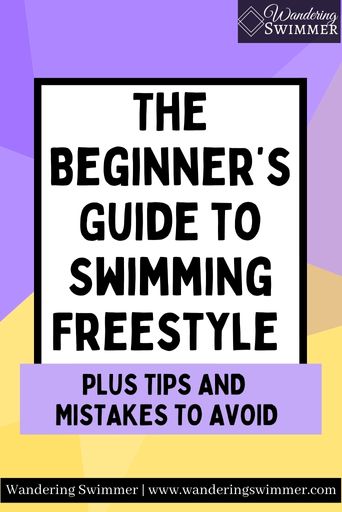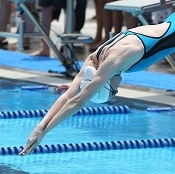In swimming, the freestyle stroke, also called the front crawl, is one of the most popular strokes for swimmers to utilize. It’s one of the first strokes taught in swim lessons and swim classes and can be argued that it’s one of the easier strokes to learn and swim.
Despite its popularity and frequent use by swimmers worldwide though, swimming freestyle isn’t without its challenges. It can be difficult for those swimmers who don’t have a basic understanding of the stroke and the technical pieces that come with it.
In this guide, we break down the many parts of the freestyle (or front crawl) stroke, along with providing some tips, and how to avoid some common mistakes.
Disclosure: This post may contain affiliate links, meaning we earn a small commission at no cost to you if you purchase something through one of our links. As an Amazon Associate, we earn from qualifying purchases. Please check out our disclosure page for more information

Freestyle vs Front Crawl: What’s the Difference?
Before we get into the overview of freestyle, we feel it’s important to touch on the subject of freestyle vs the front crawl. The names can confuse some people and we’re not here to confuse anyone! 🙂
The difference between freestyle and the front crawl is that there is no difference stroke-wise. Instead, the difference comes down to the name and definition, specifically in competitive swimming.
- Freestyle: The name of a race/event in competitive swimming in which a swimmer can swim any (legal) stroke of their choosing
- Front Crawl: A style of swimming in which the swimmer faces downwards and moves their arms alternately in strokes (source)
For this article, we will use the name freestyle to refer to the front crawl stroke.
While we understand the proper name for the stroke is the front crawl, freestyle is the more common name used for the stroke and is more accepted/understood by most swimmers.
Overview of Swimming Freestyle
What is the freestyle stroke and why is it so popular? Amongst the four common strokes, freestyle is one of the fastest swimming strokes used by swimmers and triathletes. Even water polo players use a form of freestyle when playing water polo.
And because of its efficient stroke, it’s ideal for long races and distances as swimmers can cover more ‘ground’ with less effort.
To understand a little bit more about freestyle, here is a quick overview of the stroke. We’ll review each section in a little bit 🙂 As an overview:
- The freestyle stroke is swum with the body horizontal in the water and facing the bottom of the pool
- Your arms move opposite of each other so that when one arm is under the water, the other is above the water
- The torso and hips have a slight rotation with each stroke that the swimmer takes, which helps the swimmer breathe and move through the water easier. The rotation of the hips can help drive the kick
- When breathing, the head turns to the side instead of lifting up and forward
- The legs are also horizontal in the water and move in an up-down motion that’s opposite of each other. When one leg moves up in the water, the other moves down
Those main five points are all that make up the freestyle stroke and are what you need to swim freestyle. Of course, it’s not as easy as it sounds. One of the reasons swimming is so hard is due to the technical nature of the sport/workout.
Beginner’s Guide to the Freestyle Technique
Body Position
When swimming freestyle, your body is in a horizontal position in the water and faces down toward the bottom of the pool. Or the body of water, if you’re swimming in a lake/ocean 🙂
Your head also faces down, except when you need to breathe. In freestyle, your head shouldn’t be lifted too high or pressed down too far. Doing so can be hard on your neck muscles and can mess with your balance in the water.
Related article: A Quick Guide to Body Position in Freestyle
Instead, it should remain in a neutral position. As it would when you’re standing still and looking straight ahead.
Conversely, your hips and torso don’t stay still/flat when you’re swimming. Instead, they rotate with your stroke and kick. More on that a little later!
Lastly, the position of the body when swimming freestyle should be on top of the water. If you’re finding that your body is dipping or diving under the water, then you’re not balanced. You may also be pushing yourself under the water.
Doing this can make for some exhausting freestyle and creates an excess amount of drag. Which in turn, makes swimming a lot more difficult for you.
Aim to keep your head, shoulders, torso, and hips close to the surface of the water. Yes, your arms will dip below the water for the stroke, but you shouldn’t be diving or dipping below the water.
The Freestyle Stroke and Arm Movement
Remember the definition of the front crawl as it pertained to the stroke? The freestyle stroke is defined as ‘moving the arms alternately in strokes’.
In basic terms, this means that the arms move opposite of each other so that when one arm is under the water, the other is above the water. The freestyle stroke is a constant movement between arms.
The motions of the freestyle stroke can be broken up into 6 different pieces or movements. For a more detailed explanation of each motion, please check out our article: The Freestyle Stroke and Arm Movement
Related article: 10 Drills to Help You Master the Freestyle Stroke
6 Pieces of the Freestyle Stroke
1. Entry: At this stage of the freestyle, the hand is entering the water with the tips of your fingers. Your arm will be extended out in front of you with a slight bend to your elbow
2. Catch: The freestyle stroke pulls more water with your forearm than your palm. During this motion, your forearm is moving down through the water and catching the water with the underside of your forearm.
Your elbow will bend during the process and serves as a fulcrum from which your forearm will pull down and move toward your hip. Both your forearm and palm should be facing backward.
3. Pull: Now begins the pull portion of the freestyle stroke. As your forearm moves through the water, it’s pulling the water that it previously caught during the catch. Your upper arm guides the direction backward while your elbow locks just enough to keep your forearm from going in the wrong direction.
4. Exit: At the exit, your hand is leaving the water down by your hip. The elbow leaves the water first with your forearm and hand following. You should ensure that your palm is mostly flat and is pushing the water backward. Do this instead of flicking it upwards and bending your wrist so your palm is facing up.
5. Recovery: The recovery portion of the freestyle happens when the arm is above the water and swinging forward. It’s at this stage that you should be finished breathing (if you took your breath) and your head and shoulders are starting to rotate back towards the face-down position
6. Repeat: And now you’ve come full circle, literally! After your recovery stroke, you’re back to the entry piece of the stroke. When you finish rotating, your arm is extended back in front of your body and is entering the water once more.
Rotation and Swimming Freestyle
Swimming freestyle flat is a common swimming mistake that any swimmer can make. This can occur when you’re not rotating your hips and shoulders during your stroke and kick. In turn, the lack of rotation makes it harder to breathe properly and you can’t pull water.
It’s important to note that the rotation motion in freestyle doesn’t mean that you’re rolling completely onto your side. Instead, it’s halfway between rolling to the side and staying flat in the water.
More Content for You:
It should be a more natural motion that moves in time with your stroke. Relax your hips and shoulders so that your body can rotate with the motion of your stroke.
We will note that while your body does rotate, your head should remain still. Keep it in the neutral position and only move it to roll when you breathe.
Side Breathing in Freestyle
In freestyle, you get your air by turning your head to the side to breathe and breathing in through your mouth. This is called side breathing.
Side breathing in freestyle occurs just at the exit portion of your freestyle stroke and continues halfway through the recovery. By the time your hand is passing by your face, your head will be rotating back into the water.
Related article: 7 Drills to Practice Side Breathing in Freestyle
It’s a quick motion that requires you to exhale before your face leaves the water as you don’t have time to exhale and inhale during the same stroke. You’ll get more air when you breathe if you inhale through your mouth instead of your nose.
While probably the bane of existence for most beginner swimmers, learning to side-breathe in freestyle is the best way to make swimming freestyle easier. It may seem easier to lift your head to breathe, but it’s actually more difficult, slower to do, and makes you more tired.
The Flutter Kick
You may hear the word flutter kick and freestyle kick used interchangeably but they both refer to the kick that’s used in freestyle (or the front crawl).
The flutter kick that you use in swimming freestyle is almost exactly like the flutter kick that’s used in core workouts. Your legs move opposite of each other in alternate motions so that when one leg is kicking up, the other is moving down. And so on 🙂
Your flutter kick should be a short kicking motion instead of a wide and deep kicking range. And your legs should be out straight behind you with only the slightest bend to your knees.
Related articles:
During the flutter kick, your knees should never bend like you’re peddling a bicycle. Nor should your hips bend so that your knees bend up and towards your chest.
To get the most out of your kick, engage your core muscles kick from your thighs, and rotate your hips into your stroke as you kick. This will help drive you forward and partners well with the freestyle stroke.
Common Mistakes When Swimming Freestyle
Because swimming freestyle is so technical, it’s easy for swimmers to make mistakes. Even experienced competitive swimmers can make some of these mistakes!
One of the biggest things to remember though when swimming freestyle (or any strokes) is that you don’t give up. Giving up is one of the biggest mistakes swimmers make when swimming. And while it can be hard and frustrating, mistakes can be corrected and you can always better your stroke 🙂
Knee Kicking
Kicking with your knees is one of the more common mistakes swimmers make during freestyle. It’s easy to want to bend your knees too much or bring them up to your chest. Both motions are similar to what you do on land and closely mirror doggy paddling.
Related article: 5 Common Flutter Kick Mistakes to Avoid
Instead, it’s important that you remember not to bend your knees too much when kicking. Your lower legs shouldn’t be coming out of the water and if they are, that’s a sign you’re bending your knees too much.
Remember that your kick should be shallow and with your legs straight out behind you.
Try kicking with fins to help correct this mistake in your flutter kick. The design of swim fins not only helps build strength but can also help correct excessive knee kicking.
Stroke Entry Too Wide or Tight
The freestyle stroke is tricky and varies by the swimmer. But one thing that even experienced swimmers can struggle with is keeping their stroke entry just right.
Entering the water too wide or narrow can make it more challenging to pull water during the stroke portion of your freestyle swim. And prolonged use of bad technique can also develop sore shoulders and injury.
More Content for You: The 7 Best Swim Paddles for Swimming
If your hand/arm is going in front of your face/head, then your stroke is too tight. Some swimmers may also find that they’re placing their hand as far as their opposite shoulder.
Conversely, your entry is too wide if your hand enters the water out past your shoulder. When the entry is too wide, you can’t get any power while pulling your arm through the water.
Sometimes using swim paddles, such as FINIS Freestyler Paddles, can help you find mistakes in your stroke. From correcting your entry to the catch/pull portion of your stroke, swim paddles help provide feedback for your freestyle stroke.
Lifting Your Head Up
When you swim with your head up, either to breathe or to see where you’re going, your hips will sink in the water. This can throw your stroke off-balance and make it more difficult to pull yourself through the water.
Instead, keep your head in a neutral position so that the water is hitting just between the top of your head and your forehead. You should be looking down at the bottom of the pool but not burying your head in the water so you’re forcing your shoulders down.
Front Crawl Tips
There are several different tips to learn how to swim freestyle or make it easier. Here are a few tips for swimming freestyle that we’ve found along the way that can make swimming easier for you!
- Ask for help: Swimming is complex and complicated. If you know someone who swims or you have access to a coach, ask for some help or guidance. Most swimmers are happy to give out a few pointers if you ask nicely 🙂
- Learn the basics: Take the time to go through each part of the freestyle and build up your freestyle from the start. Try the various drills until you’ve mastered each one and continue to go from there
- Take your time: Slow down your swimming and take your time. Sometimes, you need to go slower and focus on your technique instead of trying to go as fast as you can.
- Blow bubbles: Yes, it sounds silly and probably childish. But blowing bubbles prevents water from getting in your nose when you breathe. And can also help exhale the air in your lungs before getting your breath
- Breathe: Just because you’re in the water doesn’t mean you shouldn’t breathe and get air. Don’t try to hold your breath the whole length of the pool. Breathe every few strokes and stop at the end of the pool as needed to catch your breath
- Relax: It’s hard to swim when you’re tense. Tensing makes your shoulders hunch up and can cause your hips to sink. If you feel yourself growing frustrated, take a few moments to breathe and then try again. Focus on your technique and go over everything on the wall before starting
- Don’t give up: We’ve said it before but when swimming freestyle, don’t let yourself give up! You may need some time away from the pool to regroup but come back to give it another chance!
In Closing
Swimming freestyle isn’t always easy but it’s not something that can’t be mastered. Take your time and practice your drills/techniques. They’ll take you further than you expect! Remember that learning freestyle takes time and it doesn’t magically happen overnight. Despite our best wishes!
As always, happy swimming!
Chevron
Bonus Content
What Should You Take When You go Lap Swimming?: It might seem straightforward, but it never fails that you always end up needing something. So aside from your gym pass or wallet, what should you bring when you go swimming?
7 Best Waterproof MP3 Players for Swimming: While they can be on the more expensive side, getting to jam out with your favorite music while swimming is worth the cost. Here are the best waterproof MP3 players for swimming.

Want to Improve at the Pool?
Join swimmers and swim parents to receive my free newsletter and receive a free Swimming Glossary e-book as a thanks!
Every month you’ll receive tips and coaching to help you find success at the pool.
About

Chevron is a current competitive swimmer with almost 20 years of experience in the pool. And although she fell into the sport by accident in her high school years, she still trains daily and competes throughout the year. She’s committed to providing guidance to all levels of swimmers and believes that everyone should know how to swim.